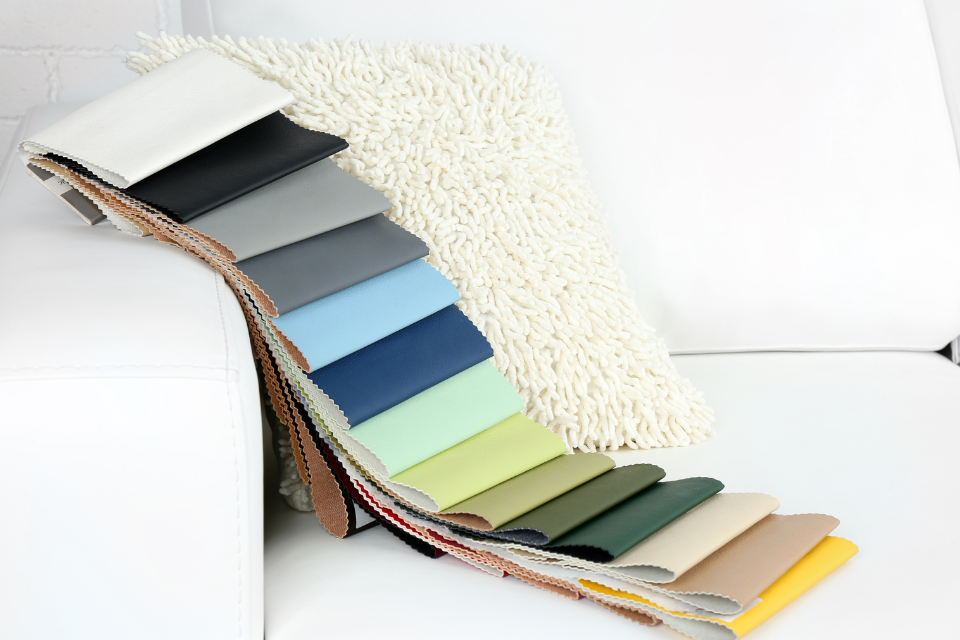Selecting the right fabric for your couch is a crucial decision that affects both the aesthetics and functionality of your living space. With a variety of natural, synthetic, blended, and high-end fabrics available, it’s important to understand the characteristics and benefits of each. This guide will explore the different types of fabrics on couches, helping you make an informed choice for your home.
Natural Fabrics
Natural fabrics are derived from plant or animal sources and are known for their breathability, comfort, and eco-friendliness.
Cotton
Cotton is one of the most popular fabrics for couches due to its softness and versatility. It is breathable, making it comfortable for all seasons. Cotton comes in various weaves and patterns, allowing for a wide range of styles. However, cotton is prone to staining and may require frequent cleaning to maintain its appearance.
Linen
Linen is valued for its natural texture and casual elegance. It is highly breathable and cool, making it ideal for warm climates. Linen is also strong and durable but can be susceptible to wrinkles and stains. With proper care, linen upholstery can last for many years, adding a timeless charm to your living space.
Wool
Wool is a durable and resilient fabric that provides excellent insulation. It is naturally resistant to wrinkling, fading, and pilling, making it a long-lasting option. Wool is also hypoallergenic and flame-resistant. However, it can be more expensive than other natural fabrics and may require professional cleaning to maintain its pristine condition.
Synthetic Fabrics
Synthetic fabrics are man-made and often designed to mimic natural fibers while offering enhanced durability and ease of maintenance.
Polyester
Polyester is a widely used synthetic fabric known for its durability and resistance to stretching and shrinking. It is also resistant to most stains and easy to clean, making it a practical choice for households with children and pets. Polyester can be blended with other fibers to create a variety of textures and finishes, offering versatility in design.
Nylon
Nylon is a strong and resilient fabric that is highly resistant to abrasion and wear. It is often used in high-traffic areas due to its durability. Nylon is also resistant to mildew and moths, making it a low-maintenance option. However, it can be less breathable than natural fabrics, which may affect comfort.
Acrylic
Acrylic is a synthetic fiber that is often used as a wool substitute due to its similar texture. It is lightweight, soft, and resistant to moths, oil, and chemicals. Acrylic fabrics are also colorfast, meaning they retain their vibrant colors over time. However, acrylic can be prone to pilling, so it may require occasional maintenance to keep it looking new.
Blended Fabrics
Blended fabrics combine natural and synthetic fibers to leverage the benefits of both, offering a balance of comfort, durability, and affordability.
Cotton-Poly Blends
Cotton-poly blends combine the softness and breathability of cotton with the durability and stain resistance of polyester. This blend creates a fabric that is comfortable, easy to clean, and more resistant to wear and tear than pure cotton. Cotton-poly blends are versatile and available in a variety of weaves and patterns, making them suitable for different styles.
Linen-Synthetic Blends
Linen-synthetic blends, such as linen-polyester, offer the natural texture and breathability of linen with the added durability and ease of maintenance of synthetic fibers. These blends can provide a more practical option for those who love the look of linen but need a fabric that can withstand daily use. The blend helps reduce wrinkles and improve stain resistance while maintaining a stylish appearance.
High-End Fabrics
High-end fabrics are luxurious and often come with a higher price tag, but they offer superior comfort, durability, and aesthetic appeal.
Leather
Leather is a premium material known for its durability and timeless elegance. It is easy to clean and becomes more attractive with age as it develops a unique patina. Leather couches are available in various grades and finishes, from smooth and polished to distressed and textured. While leather can be expensive and may require regular conditioning, its long-lasting nature makes it a worthwhile investment.
Microfiber
Microfiber is a synthetic fabric that is soft, durable, and resistant to stains and spills. It is made from tightly woven fibers, making it highly resilient and easy to clean. Microfiber mimics the feel of suede but is more affordable and practical for everyday use. Its durability and low maintenance make it a popular choice for families and high-traffic areas.
Velvet
Velvet is a luxurious fabric that adds a touch of elegance and sophistication to any room. It is soft to the touch and comes in a range of rich colors. Velvet is known for its plush texture and subtle sheen, making it a statement piece in any decor. However, velvet can be challenging to clean and may show wear over time, so it is best suited for less frequently used areas or as an accent piece.

Conclusion
Understanding the different types of fabrics on couches can help you choose the best option for your home, balancing aesthetics, comfort, durability, and maintenance needs. Whether you prefer the natural feel of cotton and linen, the practicality of synthetic fabrics, the versatility of blended materials, or the luxury of high-end options like leather and velvet, there is a perfect fabric to suit your style and lifestyle.
For a visual guide on naming the different types of couches and understanding their fabric options, you can visit this detailed guide.

Sarah Collins is a professional interior designer and home improvement expert with over 12 years of experience in the field. Her expertise spans from DIY projects to large-scale renovations, helping homeowners transform their living spaces. Sarah’s practical advice, creative ideas, and hands-on guides have made her a respected authority in home improvement.




